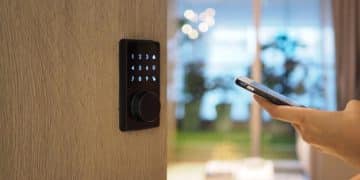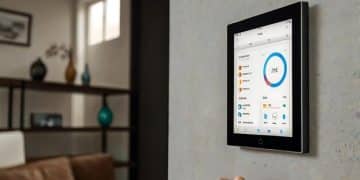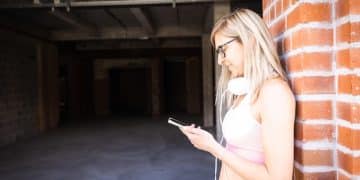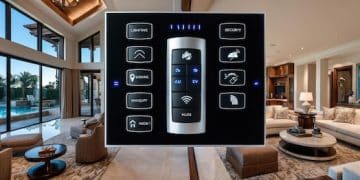DIY Smart Lock Installation: Keyless Entry Under $200
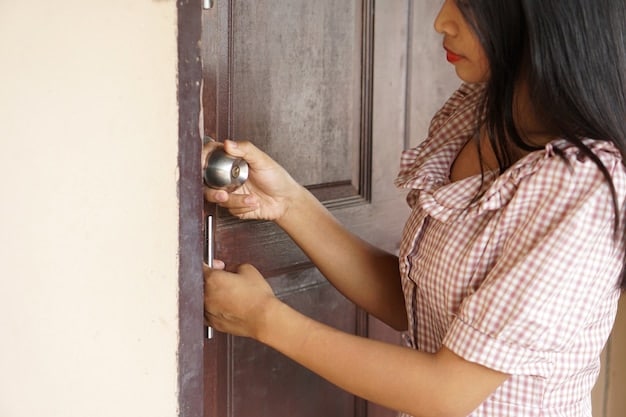
Installing a DIY smart lock can significantly enhance your home security and convenience by providing keyless entry, remote access control, and integration with other smart home devices, all for under $200 if you follow the correct steps.
Are you looking to upgrade your home security without breaking the bank? A DIY smart lock installation can provide keyless entry and enhanced security features for under $200, offering a convenient and affordable solution.
Why Choose a DIY Smart Lock Installation?
Deciding to install a smart lock yourself can be a game-changer for your home’s security and convenience. It’s not just about saving money; it’s about gaining control over your home’s access in a modern, tech-savvy way.
Cost-Effectiveness
One of the most appealing reasons to opt for a DIY smart lock installation is the cost savings. Professional installation can add a significant chunk to the overall expense, often exceeding the price of the smart lock itself.
Enhanced Security Features
Smart locks come packed with features that traditional locks simply can’t match. From remote monitoring to temporary access codes, these devices offer a new level of control and security.
- Keyless Entry: Enjoy the convenience of entering your home without fumbling for keys.
- Remote Access: Grant access to service providers or guests even when you’re not home.
- Activity Monitoring: Track who enters and exits your home in real-time.

In conclusion, a DIY smart lock installation offers a powerful combination of cost savings and enhanced security features. By taking the installation process into your own hands, you can upgrade your home without breaking the bank and enjoy the peace of mind that comes with advanced security technology.
Understanding Smart Lock Compatibility
Before diving into the installation process, it’s crucial to ensure that the smart lock you choose is compatible with your existing door hardware. This compatibility check will save you time, money, and potential headaches down the road.
Measuring Your Door
Accurate measurements are the foundation of a successful smart lock installation. Start by measuring the thickness of your door, as this will determine the correct size of the lock cylinder.
Checking Deadbolt Type
Smart locks are designed to work with existing deadbolt systems, but not all deadbolts are created equal. Identify the type of deadbolt you have to ensure compatibility.
Assessing Door Frame Alignment
A misaligned door frame can cause issues with the smart lock’s deadbolt engagement, compromising security. Check for any gaps or misalignment between the door and the frame.
- Door Thickness: Measure the door’s thickness to match the smart lock’s specifications.
- Deadbolt Throw: Ensure the deadbolt extends far enough into the door frame for secure locking.
- Strike Plate Alignment: Verify that the strike plate aligns perfectly with the deadbolt.
In summary, understanding smart lock compatibility is essential for a smooth and successful installation. By measuring your door, checking the deadbolt type, and assessing door frame alignment, you can ensure that your new smart lock integrates seamlessly with your existing hardware, providing enhanced security and convenience.
Essential Tools and Materials for Installation
Having the right tools and materials on hand is essential for a smooth and efficient smart lock installation. Gather everything you need before you start to avoid interruptions and ensure a professional-quality result.
Basic Toolkit
A basic toolkit is the foundation of any DIY project. Make sure you have the following essential tools on hand:
Smart Lock Kit Contents
Your smart lock kit should come with all the necessary components for installation. Before you begin, take inventory of the contents to familiarize yourself with each part.
Additional Materials
In addition to the basic toolkit and smart lock kit contents, you may need a few additional materials to complete the installation.
- Screwdrivers: Phillips and flathead screwdrivers for removing and installing screws.
- Drill: A drill with various drill bits for creating new holes if necessary.
- Measuring Tape: For accurate measurements to ensure proper fit.
To summarize, gathering the essential tools and materials before starting your smart lock installation is key to a smooth and successful project. With a well-equipped toolkit, a complete smart lock kit, and a few additional materials, you’ll be well-prepared to upgrade your home’s security with ease.
Step-by-Step Guide to Installing Your Smart Lock
Now that you’ve gathered your tools and materials, it’s time to dive into the actual installation process. Follow these step-by-step instructions to ensure a seamless and secure smart lock setup.
Removing the Old Lock
The first step is to remove your existing deadbolt lock. This process is usually straightforward and involves unscrewing the old hardware.
Installing the New Smart Lock
With the old lock removed, you can now install the new smart lock. Follow the manufacturer’s instructions carefully to ensure proper installation.
Connecting to Your Smart Home System
Once the smart lock is physically installed, you’ll need to connect it to your smart home system. This usually involves downloading the manufacturer’s app and following the setup instructions.
- Remove Existing Hardware: Unscrew and remove the old deadbolt lock from the door.
- Install Strike Plate: Align and install the new strike plate on the door frame.
- Test the Lock: Ensure the lock functions smoothly and securely.
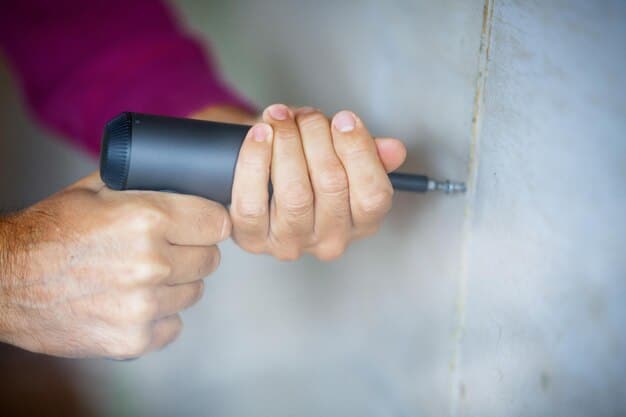
In conclusion, following this step-by-step guide will help you install your smart lock with confidence. By carefully removing the old lock, installing the new smart lock, and connecting it to your smart home system, you’ll be well on your way to enjoying the convenience and security of keyless entry.
Troubleshooting Common Installation Issues
Even with careful planning and execution, you might encounter some common issues during the smart lock installation process. Here are some troubleshooting tips to help you overcome these challenges.
Lock Not Engaging Properly
If the lock is not engaging properly, it could be due to misalignment or improper installation. Check the alignment of the strike plate and the deadbolt.
Connectivity Problems
Connectivity problems can prevent your smart lock from communicating with your smart home system. Make sure your lock is within range of your Wi-Fi network.
Battery Life Issues
Smart locks rely on batteries to function. If you’re experiencing short battery life, there are several steps you can take to troubleshoot the problem.
- Misalignment: Ensure the lock components are properly aligned for smooth operation.
- Wi-Fi Interference: Reduce interference from other electronic devices.
- Incorrect Batteries: Use the recommended battery type for optimal performance.
Overall, troubleshooting common installation issues can be straightforward with the right approach. By checking for misalignment, addressing connectivity problems, and optimizing battery life, you can resolve these challenges and enjoy the full benefits of your smart lock.
Maximizing Your Smart Lock’s Security
Installing a smart lock is just the first step toward enhancing your home’s security. There are several additional measures you can take to maximize your smart lock’s security and protect your home from potential threats.
Strong Passwords and Encryption
Using strong, unique passwords and enabling encryption are essential for protecting your smart lock from hackers and unauthorized access.
Regular Software Updates
Smart lock manufacturers regularly release software updates to address security vulnerabilities and improve performance. Make sure you keep your lock’s software up to date.
Two-Factor Authentication
Enabling two-factor authentication adds an extra layer of security to your smart lock. This requires a second form of verification, such as a code sent to your smartphone, in addition to your password.
- Complex Passwords: Use a combination of letters, numbers, and symbols for your passwords.
- Enable Encryption: Protect your data by enabling encryption on your smart lock and app.
- Enable Two-Factor Authentication: Adds an additional layer of security with a second verification method.
In summary, maximizing your smart lock’s security involves a combination of proactive measures. By using strong passwords, keeping your software up to date, and enabling two-factor authentication, you can protect your home from potential security threats and enjoy the peace of mind that comes with a secure smart home.
| Key Aspect | Brief Description |
|---|---|
| 🔑 Keyless Entry | Convenient access without traditional keys. |
| 📱 Remote Control | Manage your lock from anywhere via smartphone. |
| 🛡️ Enhanced Security | Advanced features like activity monitoring and temporary access codes. |
| 💰 Cost Savings | DIY installation saves on professional installation fees. |
FAQ
▼
Yes, by avoiding professional installation fees, you save significantly. The cost involves the smart lock itself (under $200) and basic tools you might already own.
▼
Carefully measure your door’s thickness and deadbolt type before purchasing. Some smart locks come with adjustable components or adapter kits to address compatibility issues.
▼
Smart locks use encryption and two-factor authentication to protect against hacking. Regularly update the firmware and use strong, unique passwords for added security.
▼
Most smart locks provide low-battery warnings via the app. Some also offer physical key overrides or emergency charging ports to grant access if the battery dies completely.
▼
Many smart locks integrate with popular smart home platforms like Amazon Alexa, Google Assistant, and Apple HomeKit. Check the lock’s specifications for compatibility before purchasing.
Conclusion
In conclusion, undertaking a DIY smart lock installation offers a budget-friendly way to enhance your home’s security and convenience. By carefully considering compatibility, gathering the necessary tools, and following the installation steps, you can successfully upgrade to keyless entry for under $200 and enjoy the benefits of a smarter, more secure home.
